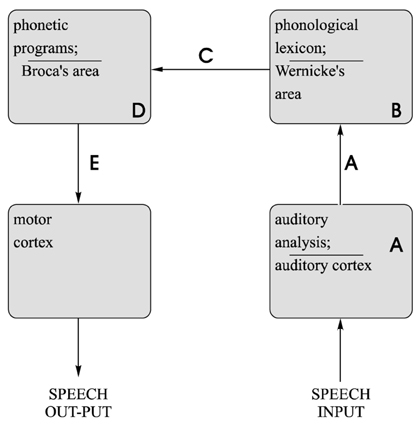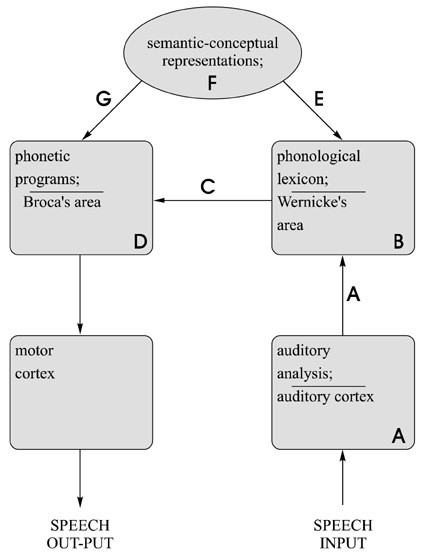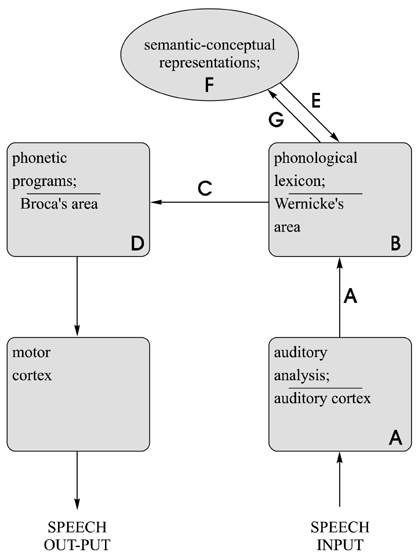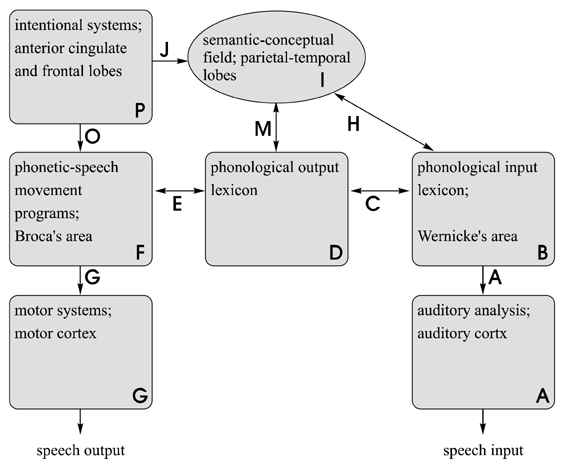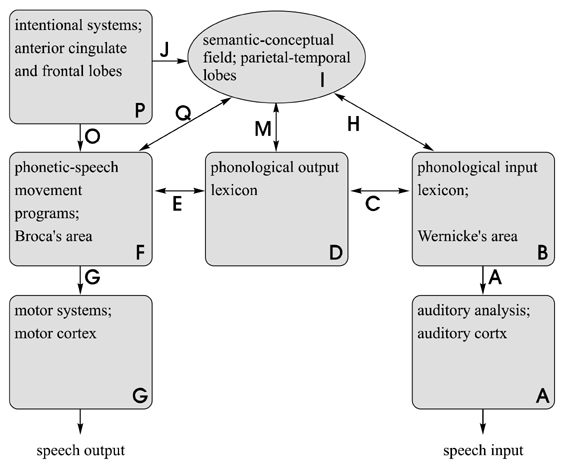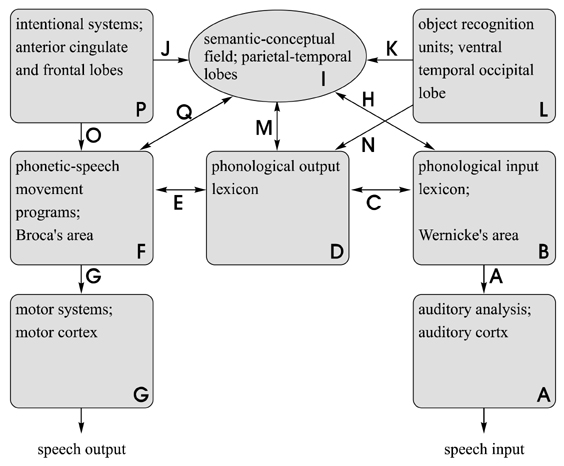J Clin Neurol.
2006 Sep;2(3):149-162. 10.3988/jcn.2006.2.3.149.
Aphasia and the Diagram Makers Revisited: an Update of Information Processing Models
- Affiliations
-
- 1The James E. Rooks Jr. Distinguished Professor, Department of Neurology, University of Florida College of Medicine, and VAMC, Gainesville, Florida, USA. heilman@neurology.ufl.edu
- KMID: 2287688
- DOI: http://doi.org/10.3988/jcn.2006.2.3.149
Abstract
- Aphasic syndromes from diseases such as stroke and degenerative disorders are still common and disabling neurobehavioral disorders. Diagnosis, management and treatment of these communication disorders are often dependent upon understanding the neuropsychological mechanisms that underlie these disorders. Since the work of Broca it has been recognized that the human brain is organized in a modular fashion. Wernicke realized that the types of signs and symptoms displayed by aphasic patients reflect the degradation or disconnection of the modules that comprise this speech-language network. Thus, he was the first to propose a diagrammatic or information processing model of this modular language-speech network. Since he first published this model many new aphasic syndromes have been discovered and this has led to modifications of this model. This paper reviews some of the early (nineteenth century) models and then attempts to develop a more up-to-date and complete model.
Keyword
Figure
Reference
-
1. Head H. Aphasia and Kindred Disorders of Speech. 1926. Volume 1. Cambridge: Cambridge University Press;54–60. Chapter 4.2. Broca P. Remarques sur le siege de la faculte du language articule, suivies d' une observation d' aphemie. Bull Soc Anat. 1861. 2:330–357.3. Trousseau A. De l' aphasie, maladie decrite recemment souls le nom improper d' aphemie. Gaz Hop. 1864. 37.4. Mohr JP, Pessin MS, Finkelstein S, Funkenstein HH, Duncan GW, Davis KR. Broca aphasia: pathologic and clinical. Neurology. 1978. 28:311–324.
Article5. Whitaker HA, Etlinger SC. Theodor Meynert's contribution to classical 19th century aphasia studies. Brain Lang. 1993. 45:560–571.
Article6. Wernicke C. Das Aphasiche Symptomenkomplex. 1874. Breslau: Cohn and Weigart.7. Bastian HC. Aphasia and Other Speech Defects. 1898. London: H. K. Lewis.8. Kussmaul A. Die Storungen der Sprache. 1877. Leipsig: Vogel.9. Lichtheim L. On Aphasia. Brain. 1885. 7:433–484.
Article10. Feinberg TE, Gonzalez-Rothi LJ, Heilman KM. Inner speech' in conduction aphasia. Arch Neurol. 1981. 43:591–593.
Article11. Heilman KM, Tucker DM, Valenstein E. A Case of Mixed Transcortical Aphasia with Intact Naming. Brain. 1976. 99:415–525.
Article12. Heilman KM, Gonzalez-Rothi LJ, McFarling D, Rottman A. Transcortical Sensory Aphasia with Relatively Spared Spontaneous Speech in Naming. Arch Neurol. 1981. 38:236–239.
Article13. Benson DF. Ardila Aphasia. 1996. New York: Oxford University Press.14. Michel F, Andreewsky E. Deep dysphasia: an analog of deep dyslexia in the auditory modality. Brain Lang. 1983. 18:212–223.
Article15. Katz RB, Goodglass H. Deep dysphasia: analysis of a rare form of repetition disorder. Brain Lang. 1990. 39:153–185.
Article16. Roth HL, Nadeau SE, Hollingsworth AL, Marie Cimino-Knight A, Heilman KM. Naming concepts: evidence of two routes. Neurocase. 2006. 12:61–70.
Article17. Freund CS. Uber optische Aophasie und Seelenblindheit. Arch. F. Psychiat. 1889. 20.18. Feinberg T, Gonzalez-Rothi LJ, Heilman KM. Multimodal agnosia from a unilateral left hemisphere lesion. Neurology. 1986. 36:864–867.
Article19. Shuren J, Geldmacher D, Heilman KM. Non-optic aphasia. Neurology. 1993. 43:1900–1907.20. Nadeau SE. Phonology: a review and proposals from a connectionist perspective. Brain Lang. 2001. 79:511–579.
Article21. Heilman KM, Voeller K, Alexander A. Developmental dyslexia: a motor articulatory feedback hypothesis. Annals of Neurology. 1996. 39:407–412.

